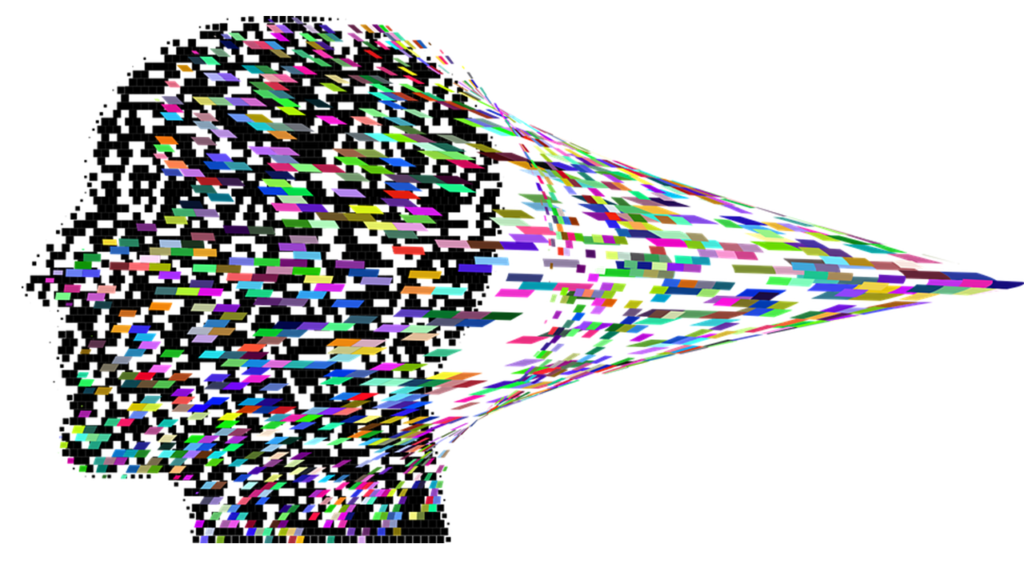Table of Contents
The Evolutionary Enigma: From Imagination to Psychosis in Humans
Primary psychosis is a mental disorder. It is characterized by false perceptions or fixed beliefs that are perceived as real due to impaired reality testing. Positive symptoms, including hallucinations and delusions are hallmarks of schizophrenia (SCZ), but psychosis can also occur in other psychiatric disorders.
Human beings possess a unique trait known as imagination, which is considered the driving force of creativity. It allows individuals to create mental images and situations that are not necessarily connected to reality.
Primary psychosis represents an extreme state of human mind can result from mental disorders such as schizophrenia. Primary psychosis is a human-specific trait that is not observed in other species.
Mind wandering and related phenomena are considered proxies for imagination, and these have been found to be similar to rapid eye movement (REM) dreaming. We know that REM dreaming is present in non-human species. Additionally, both imagination and dreaming share similarities with psychosis, such as the activation of the same brain areas during visual hallucinations and dreams.
Various genetic and epigenetic changes contribute to the structure and function of the human brain. Few of these mechanisms have been show to increase risk of schizophrenia and primary psychosis
In this article I will try to explain how imagination might evolved as an adaptation of dreaming, while primary psychosis results from deficient control by higher-order brain areas over imagination.
I have earlier written a lot about the how we dream and how that knowledge can be channelized meaningfully. I am providing links to those articles HERE and HERE.
Exploring the Evolutionary Origins of Psychosis and Imagination in Humans
The emergence of primary psychosis in human beings seems to have deep evolutionary roots. Unlike other elements of schizophrenia (SCZ), psychotic symptoms are unique to Homo sapiens. Similarly, imagination, a critical aspect of human creativity, is also likely to be exclusively human. It is possible that imagination is linked to psychosis through shared evolutionary origins. The prefrontal cortex (PFC), responsible for creativity, is the most evolutionarily novel brain structure and is most affected in the brains of those with schizophrenia. The evolutionarily novel brain structures in Homo sapiens can be explained by new patterns of gene expression, and the human-specific capacity to imagine and create is a product of activity of neuronal networks regulated by these patterns.
Abnormal functioning of neuronal networks responsible for imagination could be at the root of psychotic symptoms, as patients may not be able to distinguish between the objective reality and the pictures created by their own imagination.

It is suggested that abnormalities in embryonic brain development could be the origin of this failure. This means that the mechanisms dedicated to the control of imagination fail in psychotic patients. However, it is important to note that the mechanisms underlying the emergence of these human-specific traits are still not fully understood. One possible explanation could be human accelerated regions (HARs). HARs are genomic loci that have undergone increased rates of single nucleotide substitutions in humans. These are mostly regulatory regions and are involved in brain development. Research shows that these regions sometimes contain genetic variants that confer a risk for schizophrenia. It is believed that HARs play a key role in the evolution of human imagination and the pathogenesis of psychotic disorders.
While psychotic symptoms are unique to Homo sapiens, other elements of SCZ, such as deficits in social interaction and cognitive deficits, can be modeled in other species such as rodents. This suggests that there may be evolutionary continuity between different species, but the emergence of human-specific traits may involve more complex genetic and epigenetic changes.
Non-Coding Genetic Regions and Brain Evolution in Humans
The human brain is an outstanding feature of Homo sapiens and the study of human-specific genetic variants is crucial to understanding its evolution. These variants, including human accelerated regions (HARs), are absent in other primate, mammalian, or vertebrate species. HARs are short stretches of DNA that have undergone accelerated evolution in humans compared to other primates. There are 3,171 HARs identified so far, and they are predominantly non-coding regions of the genome.
Studies have shown that the regulation of gene expression, particularly in non-coding regions of the genome, plays a more significant role in human brain evolution than changes in protein-coding genes. For example, genes involved in neurodevelopment and processes such as neurogenesis, axon guidance, and neuron migration have undergone positive selection in non-coding regions of the genome.
(It might be a little daunting for for readers from non- biology background to understand the genetic concepts here. There is an excellent article in plain and simple language that quickly elevate your basic understanding of genetics significantly. Click HERE to access that article.)
Additionally, there are numerous evidences to suggest that human-specific gene expression regulation is crucial for proper brain function. Studies have identified differences in DNA methylation and chromatin state between human and non-human primates in regulatory regions of genes involved in brain development and susceptibility to schizophrenia (SCZ). Several genes that are regulated by HARs have been implicated in human-specific development of certain brain areas, particularly the cortex.
Furthermore, multiple studies have found associations between HARs and SCZ. SCZ-associated linkage disequilibrium blocks containing common genetic variants associated with SCZ in genome-wide association studies (GWAS) are enriched in genes putatively regulated by HARs. These genes are involved in the regulation of brain development and are primarily expressed in inhibitory GABAergic interneurons. This suggests that dysregulation of HAR-regulated genes may play a role in the pathogenesis of SCZ.

In summary, the presence of genetic variants that are specific to humans and absent in other species is an important area of study, particularly with regards to the evolution of the human brain. Non-coding regions of the genome, particularly those involved in gene expression regulation, play a significant role in human brain evolution. HARs are one type of genetic variant that has undergone accelerated evolution in humans and may be responsible for traits unique to our species. Furthermore, there is evidence to suggest that dysregulation of HAR-regulated genes may contribute to the pathogenesis of SCZ. These findings highlight the importance of studying the genetics of the human brain and may provide insights into the underlying mechanisms of neurodevelopmental disorders.
The Strange Connection between Hallucinations and Dreaming
Imagination is an essential aspect of the human experience. Imagination can be defined as the capacity to create mental images and situations that are not necessarily connected to the current reality. Imagination is the basis of creativity and artistic expression and seems to be an exclusively human faculty. It has been suggested that the human imagination may have its evolutionary roots in dreaming and be its evolutionary adaptation.
One possible proxy for human imagination is a deliberate or spontaneous stream of thought while in a relaxed state. The conceptually interrelated activities of mind wandering (MW), spontaneous thoughts, and daydreaming are neurobiologically connected to rapid eye movement (REM) sleep that has high chances of dreaming. Same brain regions that constitute the default mode network (DMN) are activated in both functions. Numerous analogies exist between brain activity during MW and REM dreaming, but a more pronounced deactivation of lateral prefrontal cortex (PFC) regions involved in cognitive control occurs during REM sleep. In addition, a disconnection of the medial PFC and temporal regions from posterior cingulate is more pronounced in REM sleep. This seems to explain the frequently odd content of dreams stemming from the lack of cognitive control and the lack of a constraint by autobiographical memory.
Dreaming that occurs during sleep is an evolutionarily old phenomenon present not only in mammals but possibly in taxa as distant as cephalopods. Based on neuroimaging data, the human imagination may have its evolutionary roots in dreaming and be its evolutionary adaptation.
Let’s now talk about hallucination– one of the hallmarks of primary psychosis. Numerous neurobiological mechanisms have been proposed to explain hallucinations. One of them is aberrant activation of sensory cortices. The aberrant activation of sensory cortices could modulate the activity of brain areas involved in cognitive control, leading to the perception of the internal activity as externally-generated. One of the possible outcomes of this failure in reality and self-monitoring could be the misattribution of the inner speech to an external source in auditory hallucinations. The neurobiological origin of hallucinations could arise from a failure to suppress irrelevant intrusive memories and a failure in recollection of the context of these memories.

Thus, REM sleep is similar to Mind Wandering (MW) with reduced connectivity, while hallucinations could result from a loss of control by higher-order brain areas over default mode network (DMN ) that is active during MW. In this sense, hallucinations could be an intrusion of REM sleep into wakefulness.
Other neurobiological similarities among these phenomena exist: similar to visual hallucinations, the visual component of REM dreams is associated with activity in sensory cortical areas of the occipital cortex; furthermore, the control by the dorsolateral PFC is reduced in both REM sleep and psychosis, albeit to different degrees. Both imagination and hallucinations include involvement of similar sensory machinery of the brain: the capacity for auditory imagery is dependent on the primary auditory cortex, and the capacity for visual imagery is dependent on the primary visual cortex.
In summary, imagination is an essential aspect of the human experience, and its evolutionary roots may be traced back to dreaming. Dreaming is an evolutionarily old phenomenon, present in several species. Similarities between imagination and hallucinations suggest that sensory parts of the brain play a crucial role in both phenomena. Furthermore, the control by higher-order brain areas over the DMN is reduced in both REM sleep and hallucinations. This reduced control may explain the odd content of dreams and the misattribution of internal speech to an external source in auditory hallucinations. Understanding the neurobiological mechanisms underlying imagination and hallucinations can shed light on the human experience and contribute to developing new treatments for mental illnesses.
How Evolutionary Changes in the Human Brain May Explain Psychosis
It seems that human imagination may have evolved as an adaptation stemming from the evolutionary old function of dreaming, with overlapping neural networks implicated in both functions. Available data suggests that human-specific accelerated regions (HARs) in the genome allowed new patterns of gene expression that determined control of the default mode network (DMN) by executive regions. Thus, HARs could be responsible for the higher-order cognitive control over human imagination that is required for a complex function and requires feedback from higher-order brain areas. The failure of higher-order brain areas to control the DMN during normal mind-wandering could lead to primary psychosis. The roots for this failure is most likely polygenic (meaning multiple genes are involved), but pathogenic variants in HARs in particular could be a significant factor in its etiology.

Challenges in linking HARs with Psychosis
The hypothesis linking primary psychosis and HARs has some limitations. First, one cannot claim with authority that the reported associations between schizophrenia (SCZ) and HARs are linked to psychotic symptoms of SCZ and are not linked with cognitive deficits. Cognitive deficits are also present in more than 85% of patients with SCZ. Furthermore, cognitive deficits in SCZ include not only “neurodegenerative,” but also neurodevelopmental components. Pathogenic genetic variants or epigenetic marks in the same HARs could be responsible for both psychosis and cognitive deficits. Secondly, we must be cognizant about the small size of HARs on the genome-wide scale. HARs constitutes only about 0.03% of the genome. Also the function of HARs was confirmed with multiple methods only for the minority of them. This means that only a smaller proportion of HARs with known functions is relevant to the pathogenesis of psychotic symptoms or the function of the DMN.
Despite this, because HARs are a product of positive selection, these sequences may have a tremendous impact on the evolution of the human brain despite the limited space they occupy in the genome.
It is important to state that HARs are most likely not the only evolutionarily novel genome regions that contributed to the emergence of human-specific brain features. Other types of genetic variants include complex genome rearrangements and a few coding genes with human-specific sequence variants. Furthermore, human-specific epigenetic modifications are associated with human brain features. Additional types of evolutionarily novel genomic regions, human gained and human lost enhancers, have different epigenetic profiles in humans compared with chimpanzee, rhesus macaque, and mouse. These could also be relevant in the pathogenesis of psychosis, although the current evidence is limited.
Way Forward
Future studies should address the hypothesis described in the article. For example, genetic variants in HARs could be compared among groups of patients with psychotic disorders categorized according to the severity of psychotic symptoms, and patients with psychosis could be compared with patients with neurodevelopmental disorders without psychosis, such as intellectual disability. The new results will contribute not only to the search for the evolutionary origins of the human brain but also to the discovery of molecular mechanisms of primary psychosis. Further research is needed to understand the evolution of human-specific traits and the molecular mechanisms underlying primary psychosis. Such research could lead to new treatments and therapies for this debilitating disorder.
(I was inspired to write this article after reading a paper that was published in Jan 2023 in the journal “Front Psychiatry” by scientists Anastasia Levchenko, Fedor Gusev and Evgeny Rogaev)






Wow, great blog post.Really thank you! Really Cool.
Thank you for the good writeup It in fact was a amusement account it Look advanced to far added agreeable from you However how could we communicate
hiI like your writing so much share we be in contact more approximately your article on AOL I need a specialist in this area to resolve my problem Maybe that is you Looking ahead to see you
I very delighted to find this internet site on bing, just what I was searching for as well saved to fav
of course like your website but you have to check the spelling on several of your posts A number of them are rife with spelling issues and I in finding it very troublesome to inform the reality on the other hand I will certainly come back again